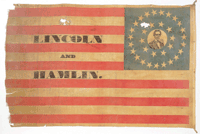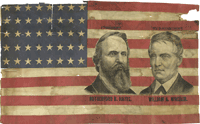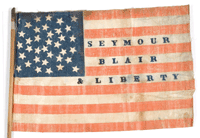|
Cowan's
Corner
Precursor to Today's Ubiquitous Yard Signs
Political Campaign Flags
By Wes Cowan
November is upon us, and that means we're besieged by political campaign
literature and television commercials. Hundreds of millions of dollars are being
spent on campaigns nationwide, with each ad vying for our attention and vote.
In this electronic age, few of us realize just how much electioneering has
changed over the history of the republic. Today, it's hard to imagine flying a
flag with a portrait of your favorite presidential candidate, but that wasn't
always the case.
In the early years of our country, there was precious little
of the sorts of activities we associate with today's heated political campaigns.
A scattered population with no real means of mass communication meant that
office seekers had little way to communicate to the general voter. This was
particularly difficult in the "West" the areas west of the Allegheny and
Appalachian Mountains. After the Revolutionary War and the War of 1812, as
settlers streamed into this vast area, the situation changed.
The
presidential election of 1840 is generally viewed as the turning point in
political campaigning, and it marks the emergence of real electioneering. The
Whig Party trotted out the old warhorse William Henry Harrison as their
candidate, running against New Yorker Martin Van Buren. Harrison's supporters
played upon his role as the hero of the Battle of Tippecanoe, touted him as "Old
Tip" and coined the phrase "Tippecanoe and Tyler Too" with a nod toward his
vice-presidential running mate, John Tyler.
Harrison clubs sprouted up all
over the country, producing a myriad of campaign ephemera, and numerous printed
textiles. Today, the early flags and banners are recognized as important and
valuable collectibles, with many fetching in the five figures.
Collectors pay
premium prices for so-called "jugate" examples. These are textiles that have
portraits of both the presidential and vice presidential candidates on the flag,
along with a campaign slogan. Naturally, the most desirable textiles are those
produced for the candidates who actually won or went on to have distinguished
careers in office. Flags and textiles associated with the 1860 and 1864 election
of Abraham Lincoln, for example, are some of the most desirable. A large flag
with Lincoln's portrait from the 1864 campaign sells readily in the mid-five
figure range.
Not all flags popular with collectors came from great
presidents, however. Flags from the disputed election of 1876, when Rutherford
B. Hayes and William Wheeler were pitted against Samuel Tilden and Thomas
Hendricks with the final outcome decided by the House of Representatives,
generate considerable excitement among collectors whenever they appear on the
market.
While campaign flags were used well into the 20th century, their
greatest period of popularity was from 1840 up until the campaign of William
McKinley in 1896. Afterwards, with the development of inexpensive celluloid,
lapel buttons sporting a portrait of the candidate along with a slogan became
wildly popular, and flags ultimately were doomed.
 About the author: Kentucky native Wes Cowan is founder and owner of Cowan's Auctions, Inc. in
Cincinnati, Ohio. An internationally recognized expert in historic Americana, Wes stars in
the PBS television series History Detectives and is a featured appraiser on Antiques
Roadshow. He can be reached via email at info@cowans.com. About the author: Kentucky native Wes Cowan is founder and owner of Cowan's Auctions, Inc. in
Cincinnati, Ohio. An internationally recognized expert in historic Americana, Wes stars in
the PBS television series History Detectives and is a featured appraiser on Antiques
Roadshow. He can be reached via email at info@cowans.com.
|

A large flag from the 1860 campaign of Abraham Lincoln that sold at Cowan's
for $66,125.

A "jugate" flag from the disputed election of 1876 of Rutherford B. Hayes and
his running mate William Wheeler. One of four known to exist, this flag sold for
$28,750 at a 2004 auction, despite obvious flaws.

An example of a "name flag;" no image of the candidate is part of the
textile. This one, from the 1868 campaign pitting Horatio Seymour against
Ulysses Grant, adds the name of his running mate, Francis Blair. It sold for
$15,525 in 2004.
|